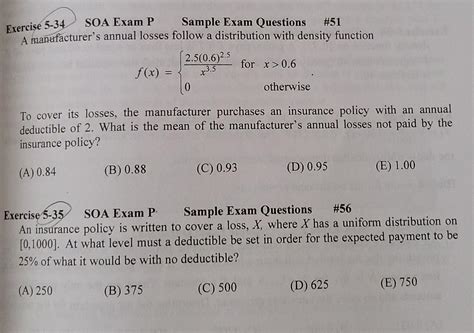The Society of Actuaries (SOA) Exam P is a fundamental examination that assesses candidates’ understanding of probability. Passing this exam is a crucial step towards becoming an actuary. To help you prepare effectively, here are some comprehensive sample questions that cover the key concepts tested on Exam P.

Exam P Sample Questions
Discrete Probability Distributions
- A fair six-sided die is rolled twice. What is the probability of getting an even number on the first roll and an odd number on the second roll?
- A bag contains 5 red balls, 3 blue balls, and 2 green balls. Two balls are drawn randomly without replacement. What is the probability of drawing a red ball first and then a green ball?
Continuous Probability Distributions
- Let X be a random variable following a normal distribution with mean μ = 50 and standard deviation σ = 10. What is the probability of X being between 40 and 60?
- The lifetime of a light bulb follows an exponential distribution with a mean of 1000 hours. What is the probability that a light bulb will last less than 800 hours?
Joint Probability Distributions
- Let X and Y be random variables following a bivariate normal distribution with correlation coefficient ρ = 0.5. If P(X < 0) = 0.4 and P(Y > 0) = 0.6, what is the probability of both X and Y being positive?
- Two fair coins are tossed simultaneously. What is the probability of getting heads on both coins?
Conditional Probability and Independence
- A company has 100 employees, 60 of whom are male and 40 of whom are female. If a male employee is chosen randomly, what is the probability that he is over 40 years old? (Assume that the probability of being over 40 years old is 0.3 for male employees and 0.2 for female employees.)
- Let A and B be two events. If P(A|B) = 0.6 and P(B) = 0.5, what is the probability of A occurring?
Expected Value and Variance
- A game of chance offers a prize of $500 with a probability of 1/10 and a prize of $200 with a probability of 2/10. What is the expected value of playing this game?
- The number of defects in a batch of 100 items follows a binomial distribution with probability of defect p = 0.05. What is the variance of the number of defects?
Common Mistakes to Avoid
- Confusing probability, odds, and risk.
- Misinterpreting the definition of independent events.
- Ignoring the possible outcomes of an experiment.
- Assuming that all distributions are normal.
- Not considering the impact of sample size on probability estimates.
Pros and Cons
Pros:
- Passing Exam P demonstrates a solid foundation in probability, which is essential for actuarial work.
- It opens up opportunities for career advancement and professional growth.
- The exam is offered twice a year, providing flexibility in scheduling.
Cons:
- The exam is challenging and requires significant study and preparation.
- The pass rates can fluctuate, making it competitive.
- It is only one of several exams required for actuarial certification.
FAQs
-
What is the passing score for Exam P?
– The passing score is determined by the SOA and can vary slightly from year to year, but it typically ranges from 60-70%. -
How long do I have to prepare for Exam P?
– Most candidates spend 200-300 hours studying for the exam. -
What is the best way to prepare for Exam P?
– Take practice exams, review the SOA syllabus, and consider using study materials such as textbooks, online courses, and tutoring services. -
When is the next Exam P sitting?
– Exam P is offered in May and November of each year. -
What are some resources for preparing for Exam P?
– The SOA provides various resources, including study notes, practice exams, and study guides.
– There are several third-party providers that offer preparation materials and online courses. -
What is the purpose of Exam P?
– Exam P is the first step in the SOA’s CAS (Casualty Actuarial Society) and FSA (Fellow of the Society of Actuaries) tracks. It tests candidates’ understanding of basic probability theory and its applications in actuarial practice.
Conclusion
Exam P is a crucial exam for aspiring actuaries. By practicing with these sample questions and addressing common mistakes, you can effectively prepare for the challenge. Remember to allocate ample time for studying, utilize available resources, and approach the exam with confidence.
